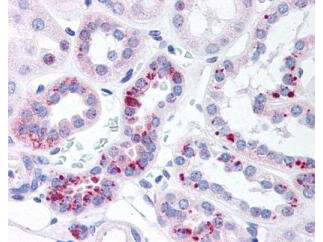Anti-STAT5 pY694 (RABBIT) Antibody
Stat5 phospho Y694 Antibody
- SPECIFICATION
- CITATIONS
- PROTOCOLS
- BACKGROUND

| Host | Rabbit |
|---|---|
| Conjugate | Unconjugated |
| Target Species | Mouse |
| Reactivity | Human |
| Clonality | Polyclonal |
Application
| WB, IHC, E, I, LCI |
| Application Note | This affinity purified antibody has been tested for use in ELISA, immunohistochemistry and western blotting. Specific conditions for reactivity should be optimized by the end user. Expect a band approximately 91 kDa in size corresponding to phosphorylated Stat5a protein by western blotting in the appropriate cell lysate or extract. This phospho-specific polyclonal antibody reacts with mouse Stat5a pY694 and shows minimal reactivity by ELISA against the non-phosphorylated form of the immunizing peptide. |
| Physical State | Liquid (sterile filtered) |
| Buffer | 0.02 M Potassium Phosphate, 0.15 M Sodium Chloride, pH 7.2 |
| Immunogen | This affinity purified antibody was prepared from whole rabbit serum produced by repeated immunizations with a synthetic peptide corresponding to residues surrounding Y694 of mouse STAT5a protein. |
| Preservative | 0.01% (w/v) Sodium Azide |
| Gene ID | 20850 |
|---|---|
| Other Names | 20850 |
| Purity | This product was affinity purified from monospecific antiserum by immunoaffinity chromatography using phospho-peptide coupled to agarose beads followed by solid phase adsorption against nonphospho-peptide. This antibody is specific for mouse Stat5a protein phosphorylated at Y694. A BLAST analysis was used to suggest cross-reactivity with Stat5a from human, mouse and rat based on 100% homology with the immunizing sequence. Cross-reactivity with Stat5a from other sources has not been determined. |
| Storage Condition | Store vial at -20° C prior to opening. Aliquot contents and freeze at -20° C or below for extended storage. Avoid cycles of freezing and thawing. Centrifuge product if not completely clear after standing at room temperature. This product is stable for several weeks at 4° C as an undiluted liquid. Dilute only prior to immediate use. |
| Precautions Note | This product is for research use only and is not intended for therapeutic or diagnostic applications. |
| Name | Stat5a |
|---|---|
| Synonyms | Mgf, Mpf |
| Function | Carries out a dual function: signal transduction and activation of transcription. Mediates cellular responses to the cytokine KITLG/SCF and other growth factors. May mediate cellular responses to activated FGFR1, FGFR2, FGFR3 and FGFR4. Binds to the GAS element and activates PRL-induced transcription. Regulates the expression of milk proteins during lactation. |
| Cellular Location | Cytoplasm. Nucleus. Note=Translocated into the nucleus in response to phosphorylation |
| Tissue Location | In the virgin, found in most tissues except brain and muscle. During lactation, abundantly found in mammary tissue, as well as in other secretory organs such as salivary gland and seminal vesicle |

Thousands of laboratories across the world have published research that depended on the performance of antibodies from Abcepta to advance their research. Check out links to articles that cite our products in major peer-reviewed journals, organized by research category.
info@abcepta.com, and receive a free "I Love Antibodies" mug.
Provided below are standard protocols that you may find useful for product applications.
Background
This antibody is designed, produced, and validated as part of a collaboration between Rockland and the National Cancer Institute (NCI) and is suitable for Cancer, Immunology and Nuclear Signaling research. Signal transducer and activator of transcription 5 (Stat5) belongs to a family of cytoplasmic transcription factors that can be activated (phosphorylated) by a cell surface receptor. Phosphorylation at Tyr694 is obligatory for Stat5 activation. Stat5 has two isoforms, Stat5a and Stat5b. Aberrant Stat5 activation has been implicated in the pathogenesis of chronic myelogenous leukemia, prostate and breast cancer and tumor metastasis. Stat5 is localized in the cytoplasm and upon phosphorylation at Y694 is translocated to the nucleus.
If you have used an Abcepta product and would like to share how it has performed, please click on the "Submit Review" button and provide the requested information. Our staff will examine and post your review and contact you if needed.
If you have any additional inquiries please email technical services at tech@abcepta.com.













 Foundational characteristics of cancer include proliferation, angiogenesis, migration, evasion of apoptosis, and cellular immortality. Find key markers for these cellular processes and antibodies to detect them.
Foundational characteristics of cancer include proliferation, angiogenesis, migration, evasion of apoptosis, and cellular immortality. Find key markers for these cellular processes and antibodies to detect them. The SUMOplot™ Analysis Program predicts and scores sumoylation sites in your protein. SUMOylation is a post-translational modification involved in various cellular processes, such as nuclear-cytosolic transport, transcriptional regulation, apoptosis, protein stability, response to stress, and progression through the cell cycle.
The SUMOplot™ Analysis Program predicts and scores sumoylation sites in your protein. SUMOylation is a post-translational modification involved in various cellular processes, such as nuclear-cytosolic transport, transcriptional regulation, apoptosis, protein stability, response to stress, and progression through the cell cycle. The Autophagy Receptor Motif Plotter predicts and scores autophagy receptor binding sites in your protein. Identifying proteins connected to this pathway is critical to understanding the role of autophagy in physiological as well as pathological processes such as development, differentiation, neurodegenerative diseases, stress, infection, and cancer.
The Autophagy Receptor Motif Plotter predicts and scores autophagy receptor binding sites in your protein. Identifying proteins connected to this pathway is critical to understanding the role of autophagy in physiological as well as pathological processes such as development, differentiation, neurodegenerative diseases, stress, infection, and cancer.


